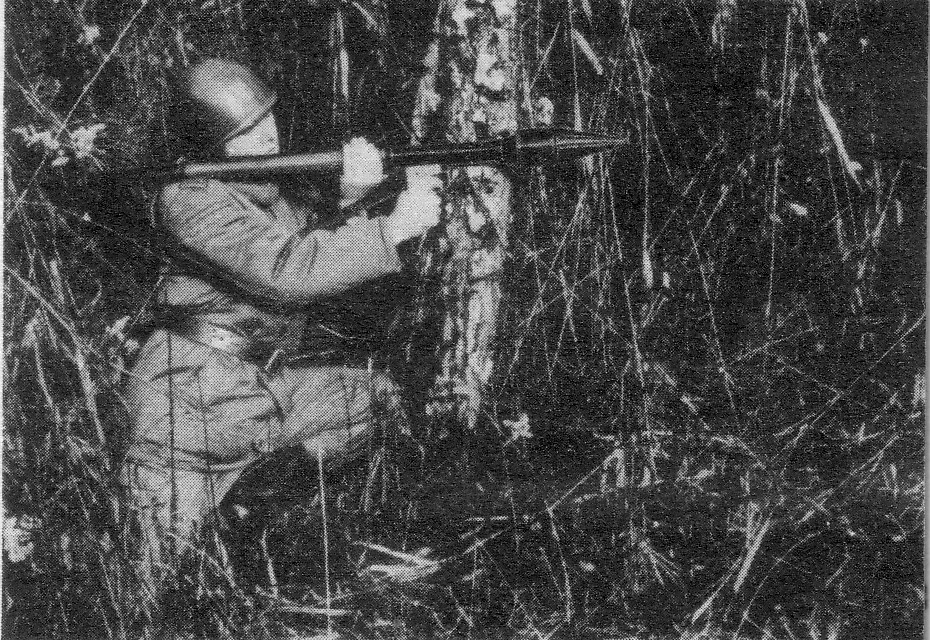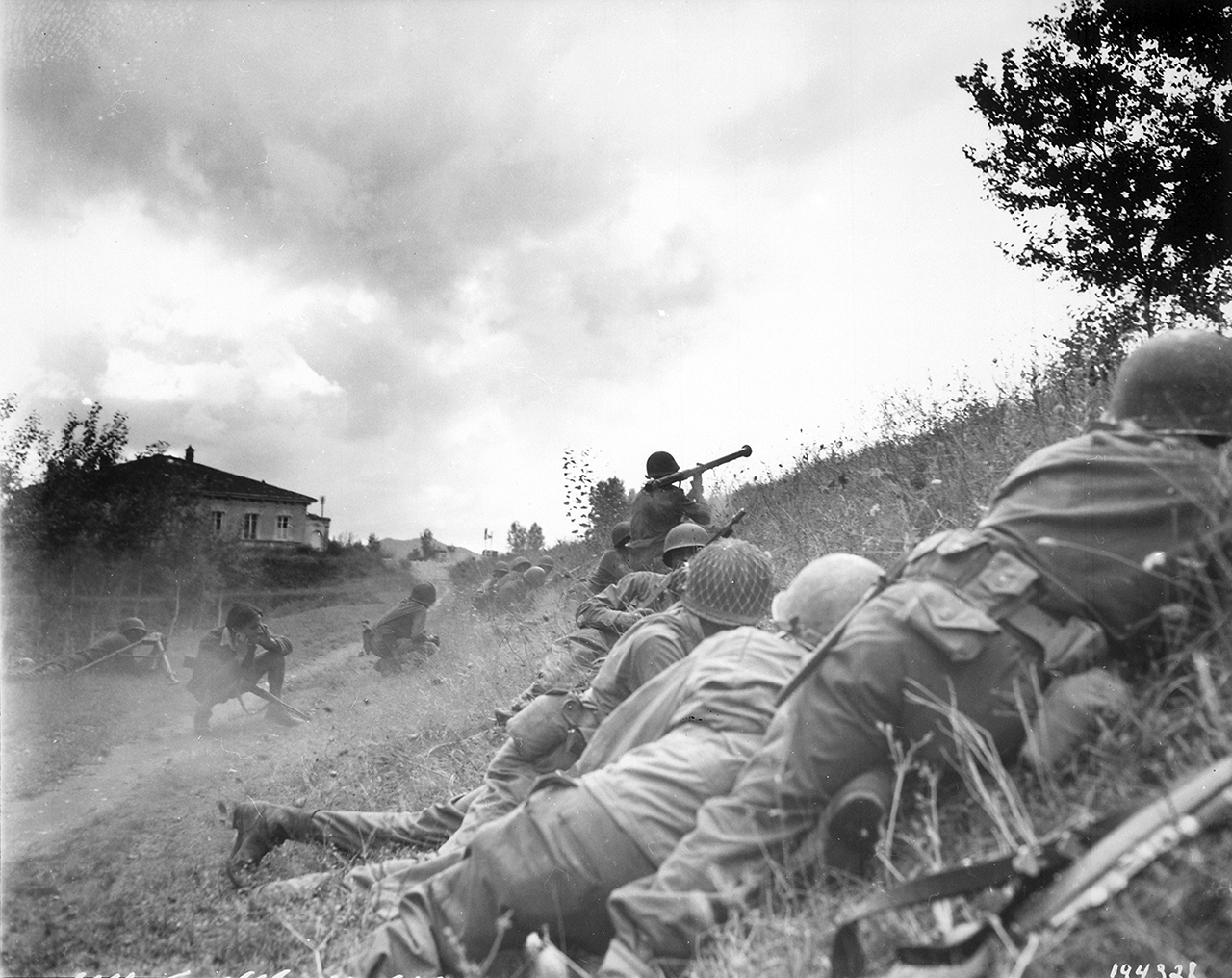|
RPG-1
The RPG-1 (russian: РПГ-1, links=no, , ''Ruchnoy Protivotankovy Granatomyot-1''; en, Hand-held Anti-tank Grenade Launcher-1) was a Soviet lightweight anti-tank rocket equipped with a shaped charge warhead. The design was inspired by similar weapons being introduced by the US and Germany in the late-World War II period. Work on the design began in 1944 and continued until 1948, but it was not put into production, as the RPG-2 was selected for this role instead. The RPG-1 introduced the basic physical and mechanical layout that was also used on the RPG-2 and the much more famous and ubiquitous RPG-7. History In 1944 the Soviets extensively tested new anti-tank weapons, including the German ''Panzerfaust'' and ''Panzerschreck'' as well as the US bazooka. They decided to produce their own design combining the best features of all of these, and started development under G.P. Lominskiy at the Main Artillery Directorate's Small Arms and Mortar Research Range. Initially known as the ... [...More Info...] [...Related Items...] OR: [Wikipedia] [Google] [Baidu] |
RPG-1
The RPG-1 (russian: РПГ-1, links=no, , ''Ruchnoy Protivotankovy Granatomyot-1''; en, Hand-held Anti-tank Grenade Launcher-1) was a Soviet lightweight anti-tank rocket equipped with a shaped charge warhead. The design was inspired by similar weapons being introduced by the US and Germany in the late-World War II period. Work on the design began in 1944 and continued until 1948, but it was not put into production, as the RPG-2 was selected for this role instead. The RPG-1 introduced the basic physical and mechanical layout that was also used on the RPG-2 and the much more famous and ubiquitous RPG-7. History In 1944 the Soviets extensively tested new anti-tank weapons, including the German ''Panzerfaust'' and ''Panzerschreck'' as well as the US bazooka. They decided to produce their own design combining the best features of all of these, and started development under G.P. Lominskiy at the Main Artillery Directorate's Small Arms and Mortar Research Range. Initially known as the ... [...More Info...] [...Related Items...] OR: [Wikipedia] [Google] [Baidu] |
RPG-2
The RPG-2 (Russian: РПГ-2, Ручной противотанковый гранатомёт, ''Ruchnoy Protivotankovy Granatomyot''; English: "hand-held antitank grenade launcher") is a man-portable, shoulder-fired anti-tank weapon that was designed in the Soviet Union. It was the first successful anti-tank weapon of its type, being a successor to the earlier and unsuccessful RPG-1. The RPG-2 offered better range and armor penetration, making it useful against late and post-World War II tanks, in contrast to the RPG-1 that had only marginal utility. The basic design and layout was further upgraded to produce the ubiquitous RPG-7. History Studying German and US anti-tank rocket designs, in 1944 the Soviets began development of the RPG-1 with the goal of combining the best features of the German ''Panzerfaust'' single shot recoilless weapon with the US Bazooka rocket launcher. Propelled by a 30 mm cartridge, the high explosive anti-tank (HEAT) round could penetrate about of ... [...More Info...] [...Related Items...] OR: [Wikipedia] [Google] [Baidu] |
Soviet Union
The Soviet Union,. officially the Union of Soviet Socialist Republics. (USSR),. was a transcontinental country that spanned much of Eurasia from 1922 to 1991. A flagship communist state, it was nominally a federal union of fifteen national republics; in practice, both its government and its economy were highly centralized until its final years. It was a one-party state governed by the Communist Party of the Soviet Union, with the city of Moscow serving as its capital as well as that of its largest and most populous republic: the Russian SFSR. Other major cities included Leningrad (Russian SFSR), Kiev (Ukrainian SSR), Minsk ( Byelorussian SSR), Tashkent (Uzbek SSR), Alma-Ata (Kazakh SSR), and Novosibirsk (Russian SFSR). It was the largest country in the world, covering over and spanning eleven time zones. The country's roots lay in the October Revolution of 1917, when the Bolsheviks, under the leadership of Vladimir Lenin, overthrew the Russian Provisional Government ... [...More Info...] [...Related Items...] OR: [Wikipedia] [Google] [Baidu] |
Anti-tank Rocket
Anti-tank warfare originated from the need to develop technology and tactics to destroy tanks during World War I. Since the Triple Entente deployed the first tanks in 1916, the German Empire developed the first anti-tank weapons. The first developed anti-tank weapon was a scaled-up bolt-action rifle, the Mauser 1918 T-Gewehr, that fired a 13mm cartridge with a solid bullet that could penetrate the thin armor of tanks of the time and destroy the engine or ricochet inside, killing occupants. Because tanks represent an enemy's strong force projection on land, military strategists have incorporated anti-tank warfare into the doctrine of nearly every combat service since. The most predominant anti-tank weapons at the start of World War II in 1939 included the tank-mounted gun, anti-tank guns and anti-tank grenades used by the infantry, and ground-attack aircraft. Anti-tank warfare evolved rapidly during World War II, leading to the inclusion of infantry-portable weapons such a ... [...More Info...] [...Related Items...] OR: [Wikipedia] [Google] [Baidu] |
Shaped Charge
A shaped charge is an explosive charge shaped to form an explosively formed penetrator (EFP) to focus the effect of the explosive's energy. Different types of shaped charges are used for various purposes such as cutting and forming metal, initiating nuclear weapons, penetrating armor, or perforating wells in the oil and gas industry. A typical modern shaped charge, with a metal liner on the charge cavity, can penetrate armor steel to a depth of seven or more times the diameter of the charge (charge diameters, CD), though greater depths of 10 CD and above have been achieved. Contrary to a misconception (possibly resulting from the acronym for ''high-explosive anti-tank'', HEAT) the shaped charge EFP jet does not depend in any way on heating or melting for its effectiveness; that is, the EFP jet from a shaped charge does not melt its way through armor, as its effect is purely kinetic in nature – however the process does create significant heat and often has a significant ... [...More Info...] [...Related Items...] OR: [Wikipedia] [Google] [Baidu] |
World War II
World War II or the Second World War, often abbreviated as WWII or WW2, was a world war that lasted from 1939 to 1945. It involved the vast majority of the world's countries—including all of the great powers—forming two opposing military alliances: the Allies and the Axis powers. World War II was a total war that directly involved more than 100 million personnel from more than 30 countries. The major participants in the war threw their entire economic, industrial, and scientific capabilities behind the war effort, blurring the distinction between civilian and military resources. Aircraft played a major role in the conflict, enabling the strategic bombing of population centres and deploying the only two nuclear weapons ever used in war. World War II was by far the deadliest conflict in human history; it resulted in 70 to 85 million fatalities, mostly among civilians. Tens of millions died due to genocides (including the Holocaust), starvation, ma ... [...More Info...] [...Related Items...] OR: [Wikipedia] [Google] [Baidu] |
RPG-7
The RPG-7 (russian: link=no, РПГ-7, Ручной Противотанковый Гранатомёт, Ruchnoy Protivotankoviy Granatomyot) is a portable, reusable, unguided, shoulder-launched, anti-tank, rocket-propelled grenade launcher. The RPG-7 and its predecessor, the RPG-2, were designed by the Soviet Union, and are now manufactured by the Russian company Bazalt. The weapon has the GRAU index (Russian armed forces index) 6G3. The ruggedness, simplicity, low cost, and effectiveness of the RPG-7 has made it the most widely used anti-armor weapon in the world. Currently around 40 countries use the weapon; it is manufactured in several variants by nine countries. It is popular with irregular and guerrilla forces. The RPG has been used in almost all conflicts across the world since the mid-1960s from the Vietnam War to the 2022 Russo-Ukrainian War. Widely produced, the most commonly seen major variations are the RPG-7D (десантник – ''desantnik'' – paratro ... [...More Info...] [...Related Items...] OR: [Wikipedia] [Google] [Baidu] |
Panzerfaust
The ''Panzerfaust'' (, "armour fist" or "tank fist", plural: ''Panzerfäuste'') was a development family of single-shot man-portable anti-tank systems developed by Nazi Germany during World War II. The weapons were the first single-use light anti-tank weapons based on a pre-loaded disposable launch tube, a weapon configuration which is still used today (two modern examples being the AT4 and NLAW). The ''Panzerfaust''-design consisted of a light recoilless launcher tube outfitted with a single pre-loaded high-explosive anti-tank warhead protruding from the muzzle, much like a "fist", hence the name. It was an inexpensive, easy-to-use anti-tank weapon for the common infantry man, being issued as a single unit of ammunition meant to be operated by a single soldier. Firing was done from under the arm at an upward angle as the effective firing range was barely beyond that of hand grenades ( max). After use the launcher was disposed of, much like the safety pin in hand grenades. Deve ... [...More Info...] [...Related Items...] OR: [Wikipedia] [Google] [Baidu] |
Panzerschreck
''Panzerschreck'' (lit. "tank fright", "tank's fright" or "tank's bane") was the popular name for the ''Raketenpanzerbüchse'' 54 ("Rocket Anti-armor Rifle Model 54", abbreviated to RPzB 54), an 88 mm reusable anti-tank rocket launcher developed by Nazi Germany in World War II. Another earlier, official name was ''Ofenrohr'' ("stove pipe"). The ''Panzerschreck'' was designed as a lightweight infantry anti-tank weapon and was an enlarged copy of the American bazooka. The weapon was shoulder-launched and fired a fin-stabilized rocket with a shaped-charge warhead. It was made in smaller numbers than the ''Panzerfaust'', which was a light, disposable anti-tank weapon that used a system not unlike those of recoilless rifles. History The ''Panzerschreck'' development was initially based on the American "bazooka", captured during the Tunisian campaign, November 1942. The ''Panzerschreck'' was larger and heavier than its American counterpart – the ''Panzerschreck'' had an 88 ... [...More Info...] [...Related Items...] OR: [Wikipedia] [Google] [Baidu] |
Bazooka
Bazooka () is the common name for a Man-portable anti-tank systems, man-portable recoilless Anti-tank warfare, anti-tank rocket launcher weapon, widely deployed by the United States Army, especially during World War II. Also referred to as the "stovepipe", the innovative bazooka was among the first generation of rocket-propelled grenade, rocket-propelled anti-tank weapons used in infantry combat. Featuring a solid-propellant rocket for propulsion, it allowed for High-explosive anti-tank warhead, high-explosive anti-tank (HEAT) warheads to be delivered against Vehicle armour, armored vehicles, machine gun nests, and fortified bunkers at ranges beyond that of a standard thrown grenade or land mine, mine. The universally applied nickname arose from the M1 variant's vague resemblance to the musical instrument called a "bazooka (instrument), bazooka" invented and popularized by 1930s American comedian Bob Burns (humorist), Bob Burns. During World War II, the Nazi Germany, German arm ... [...More Info...] [...Related Items...] OR: [Wikipedia] [Google] [Baidu] |
HEAT
In thermodynamics, heat is defined as the form of energy crossing the boundary of a thermodynamic system by virtue of a temperature difference across the boundary. A thermodynamic system does not ''contain'' heat. Nevertheless, the term is also often used to refer to the thermal energy contained in a system as a component of its internal energy and that is reflected in the temperature of the system. For both uses of the term, heat is a form of energy. An example of formal vs. informal usage may be obtained from the right-hand photo, in which the metal bar is "conducting heat" from its hot end to its cold end, but if the metal bar is considered a thermodynamic system, then the energy flowing within the metal bar is called internal energy, not heat. The hot metal bar is also transferring heat to its surroundings, a correct statement for both the strict and loose meanings of ''heat''. Another example of informal usage is the term '' heat content'', used despite the fact that p ... [...More Info...] [...Related Items...] OR: [Wikipedia] [Google] [Baidu] |








